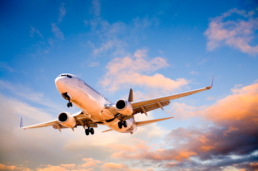Advancing Sustainable Aviation: Challenges and Opportunities in the Mission for Net Zero
11.01.2024 In a recent update on Sustainable Aviation Fuel (SAF), the International Air Transport Association (IATA) shared encouraging data, revealing that SAF production volumes soared to over 600 million litres in the past year, a remarkable doubling from the figures of 2022. Despite this significant progress, SAF still accounted for merely 3% of all renewable fuels produced in 2023, with a staggering 97% directed to other transport sectors.
Lighthouse Green Fuels will play a pivotal role in the ongoing decarbonisation efforts within the aviation sector, producing 165 million litres of SAF annually once the commercial operation commences in 2028, Additionally, Alfanar aims to develop two more SAF plants within the next 5 years, further contributing to the industry's sustainability goals.
However, the aviation industry faces a critical juncture in its mission to achieve net-zero carbon emissions by 2050. To be on the trajectory for success, renewable fuel production needs to surge to 25% to 30% by 2030, a substantial leap from the current 3%. By the end of this year, the target is to reach 6%, tripling the production figures from 2022. While this is a commendable advancement, it still only addresses a mere 0.53% of the global aviation demand.
One of the key hurdles in the widespread adoption of SAF is the persistent challenge of cost and the lack of policy and price support for SAF producers and airlines. Despite the rapid growth in aviation emissions, surpassing those of rail, road, or shipping on a year-on-year basis, the sector remains in need of substantial backing to make sustainable practices economically viable.
Interestingly, it has been estimated that a significant 85% of SAF facilities planned for construction over the next five years will rely on Hydroprocessed Esters and Fatty Acids (HEFA) production technology. HEFA predominantly utilises inedible animal fats (tallow), used cooking oil, and industrial grease as feedstock. While HEFA is a valuable contributor, there is a pressing need to diversify SAF production through other certified pathways to prevent potential challenges arising from low feedstock supply.
One promising alternative is Fischer-Tropsch (FT) technology, a pathway we employ. Unlike HEFA, FT allows for a broader range of feedstocks, opening the door to increased flexibility and sustainability in SAF production. By embracing diverse feedstocks, the aviation industry can fortify its commitment to decarbonisation and move closer to achieving the ambitious targets set for 2030 and beyond.
In conclusion, while the recent surge in SAF production is a positive sign for the aviation industry's commitment to sustainability, the road to net-zero emissions by 2050 remains challenging. Tackling issues of cost, policy support, and diversification of production pathways are pivotal steps in ensuring that the aviation sector meets its environmental obligations. By harnessing the potential of Fischer-Tropsch technology and exploring other certified pathways, the aviation industry can chart a course toward a more sustainable and environmentally responsible future.
